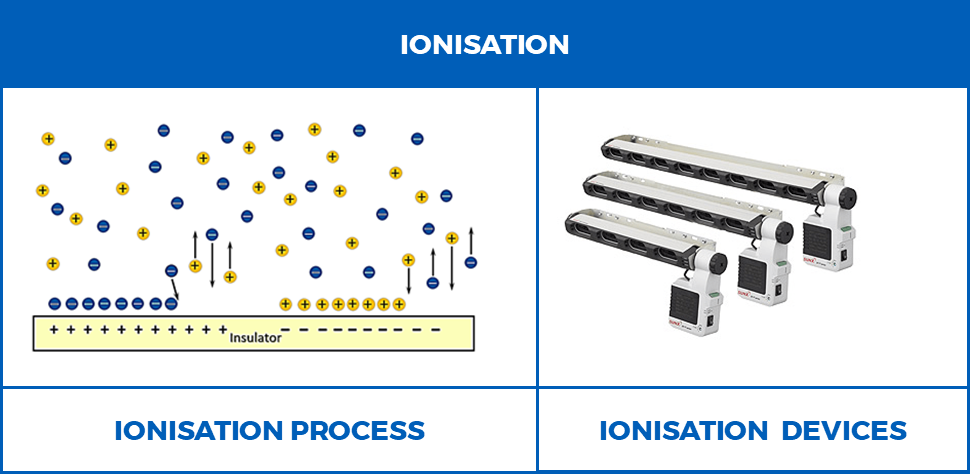COMBATTING STATC ELECTRICITY IN YOUR PLANT
Static electricity can cause serious problems within the manufacturing environments from product quality issues to worst case scenario sparks being generated risking fire and explosion.
What causes static electricity?
Static electricity is caused when two materials rub against each other. Typically, the surface of every material has both protons(+) and electrons (-), with their charges being balanced; meaning the overall object has a neutral charge. However, when two objects rub against each other, the charges are separated and an electron or proton can move from one object to the other, resulting in each object becoming either positively or negatively charged. These objects will then attract (or repel) other objects.
So why is this a problem?
If two objects with a different electric potential are placed close together and if the voltage difference is sufficiently high, a spark can occur. Sparks can cause a serious risk of fires and explosions especially in environments where there are flammable materials or in environments where there is a lot of dust or fine powders.
While the creation of a spark is the most serious result of static electricity, static electricity can also interfere with the production process in other ways such as:
- dust contamination
- products clinging to each other
- contaminants getting into product
- plastic sheets not separating properly
- potential damage to machinery
- shocks to operators
What factors affect the creation of static electricity?
- The weather
The dryer the air the greater the static build-up. Controlling the atmosphere in your production facility can reduce the risk of static electricity build-up. - The type of materials being used
Some materials are more readily charged than others. For example, materials such as acetate will gain a charge very readily whilst glass will gain a charge less readily.
- Repetition
Repeated actions such as constant friction or separation will increase the level of charge found on a material. For example, a plastic web moving over a series of Teflon rollers will increase its surface charge after every roller. - Battery Effect
The combination of many charged items can lead to extremely high charges. For instance, individual sheets of plastic with relatively low surface charges when stacked together can generate extremely high voltages. - Change In Temperature
As a material cools down it can generate charge.
Controlling static electricity
While the generation of static electricity cannot be stopped, its accumulation and dispersal can be controlled through:
- correctly designing machinery, pipes and filtration systems
- bonding and grounding of equipment
- humidity control
- additives – antistatic additives can be added to liquids such as fuel to increase conductivity and reduce electrostatic build-up
- Material, flooring and clothing – conductive flooring, shoe soles and clothing can help dissipate static charges from a person as they walk or move around
- the introduction of Ionisers to your production line.
What are Ionisers
Air Ionisers make the air sufficiently conductive to dissipate static charge. Whatever static charge is present on objects in the work environment will be reduced and neutralised by attracting opposite polarity charges from the air. Because it uses only the air that is already present in the work environment, air ionisation may be employed even in cleanrooms where chemical sprays and some static dissipative materials are not usable.

Some ionisation devices require airflow to operate properly and may incorporate fans in their design.
Static electricity is an invisible hazard in many production environments. If you would like advice on steps to protect your plant from static electricity, get in touch with the EAS team today on 07 834 0505 or [email protected]

Leave a Reply
Want to join the discussion?Feel free to contribute!